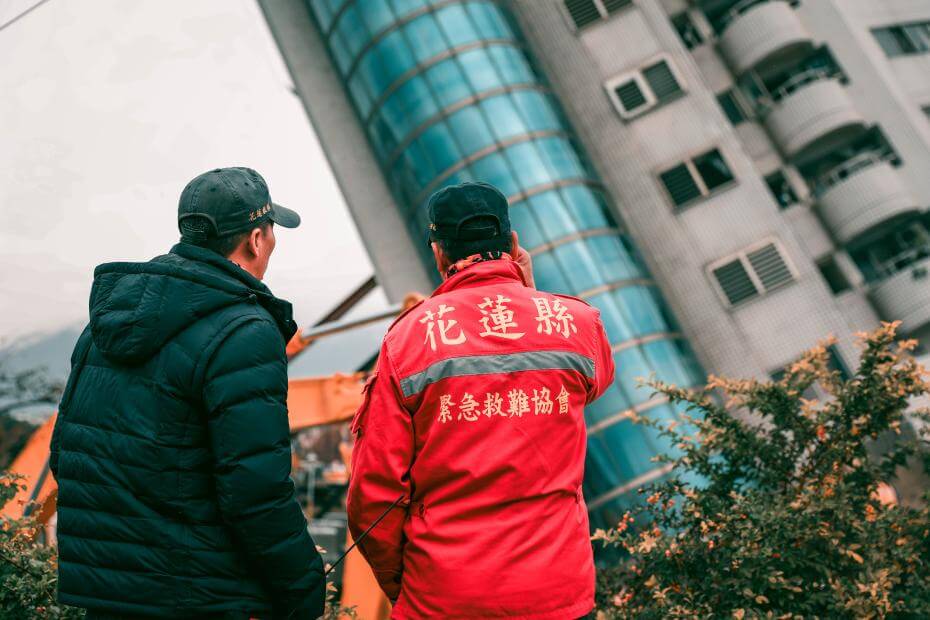2019-11-22|撰文者:台北當代藝術館/非池中藝術網編輯整理
災難的靈視:拒絕內心被災難吞噬
 安聖惠(峨冷‧魯魯安)《消失前的最後嘆息》。圖/台北當代藝術館提供
安聖惠(峨冷‧魯魯安)《消失前的最後嘆息》。圖/台北當代藝術館提供
「球莖思維以關係詩學為原則」
(〈漂流、放逐〉,埃鐸瓦.葛里松,1990)
二十一世紀至今已近二十年,我們正面對到一種矛盾的景況,一邊是各種明顯且大規模的失控,從心理、家庭、社會、政治到氣候,另一邊則是新型控制系統與運算邏輯的降臨,人變成了數據的容器,並在大數據運算中成為進行勞動、消費的殭屍;這個悖論不僅涉及到社會和國家為尺度的政治問題,也指出人的智能與技術發展,將整個地球捲入到開發漩渦後所引發的變化,揭示出「地球作為開發對象」這幻象破滅後的人類窘境。
於是,災難從「天災」發展到「人禍」,甚至在今天混雜成天災人禍無法區分的「共業」,隨著人類技術與知識對「自然」與「環境」的控制能力越發強大,失序也就成為更為頻繁的日常,甚至在資本競爭的全面化底下,「控制」成為主要手段、「災難」成為家常便飯,並在民主的要求與發展下,「控制」深入到生命與身體的內部、「災難」的承擔也從非人之責到無人負責。正是在這個處境下,災難不再是人類矇昧無知的恐懼和對於懲罰的想像,而真正以另一種樣貌成為問題(polemic Gaia)「蓋婭」:我們與萬物的生命延展造就地球與它的流變。傳統領域的變異就如同瞬間躍出、在大地上磨出灼臉扭曲的普悠瑪號,是層疊地景、人跡、獸影、電流、數據的地層,地震的搖撼與翻攪或許就是為了顯現災難是地質層的事實。
以皮耶.雨格在智利阿塔卡馬沙漠的「印歿丘」開啟一個自然與人禍交互糾纏的末世景象,Chim↑Pom在核災與奧運的追問中,以培力行動批判並抵抗「發展」邏輯下相繼出現的廢墟,來自東部的學生(曾湘淇、羅詩蘋、王茹霖)與香港的學生(反送中關注組)則分別表達出對於天災與人禍的創造性回應,與層層深挖的感知地層;而風間幸子的版印作品則從殖民現代性的東移,到日本的現代發展版圖,並重回到殖民與發展所糾結的精神分裂。而阮英俊重回因開礦而變貌的家鄉,連呼吸道都充滿著全球資本開發的脈波,相應的加藤翼則與民眾以象徵地標的重建,培蓄面對未來的精神力;到了陳瀅如和洪子健以小說重建「透納之屋」,並將其連結上白人主義在現代歷史發展上的重要角色,以此回溯人類現代歷史發展的變態動力。延伸到周滔用沈靜的地景訴說生命與環境的重新癒合,這個弔詭(paradoxical)的靜默將我們導引到激烈異常的哀悼,無論是艾未未對於難民生命狀態的追念,以及巴卡芙萊用紅藜、藤蔓和竹枝釘裝出的心臟重新懷想原住民的生命流放,乃至於安聖惠將過去災難所造成的創傷沈積在纏繞而暗沈的雕塑中。最後,我們看到即將被淹沒的臺北,吳繼濤將災難置入陰鬱、飄渺卻又彷彿圓滿的弔詭狀態。災難中的靈視,不是為了用藝術來記取奇觀,而是不讓內心被災難吞噬。

 羅詩蘋《震後群》。圖/台北當代藝術館提供
羅詩蘋《震後群》。圖/台北當代藝術館提供
Co/Inspiration in Catastrophes
“Rhizomatic thought is the principle behind what I call the Poetics of Relation.”
(“Errantry, Exile,” Édouard Glissant, 1990.)
Almost twenty years after the arrival of the 21st century, human beings are now faced with a contradiction: on the one hand, there has been a wide range of obvious and large-scale out-of-control situations – whether it is people’s psychological condition, family, society, politics or the climate – and a new control system and operation logic have emerged, turning humans into vessels of data, i.e. zombie-like laborers and consumers in the operation of big data. This paradox not only involves political issues on a social and national scale, but also points to the changes occurred after human’s intellect and technological advancement have enveloped the entire Earth in a vortex of development, exposing the dilemma resulting from the disillusionment of “Earth as an object of development.”
Consequently, catastrophes have evolved from “natural disasters” to “man-made calamities,” and even become “shared karmic consequences” that mix natural and man-made disasters. As technology and knowledge have growing control over “nature” and “environment,” disorder has now become more frequent and part of the everyday life. In the era of total capital competition, “control” becomes a dominant approach, and “catastrophes” seem to happen on a regular basis. Due to the demand and development of democracy, “control” now extends into our lives and bodies; and “catastrophes” have changed from “nobody’s fault” to “no one’s responsibility.” It is circumstances like these that catastrophes have progressed from being the embodiment of human’s ignorant fear and imagined punishment to assume another role—the polemic Gaia: the continuation of the human race and other creatures have shaped the Earth and caused its changes. The variation of the traditional territory happens quickly and drastically, like a suddenly derailed train that scrapes and distorts the surface of the Earth, and forms strata of layered landscape, human and animal activities, electric currents and data. Perhaps, the shaking and stirring of earthquakes are to reveal that catastrophes are indeed geological layers.
The exhibition opens with Pierre Huyghe’s Cerro Indio Muerto, an image taken at Chile’s Atacama Desert, which introduces us into an apocalyptic landscape that mixes natural and man-made disasters. Chim↑Pom questions nuclear disaster and the Olympics Games while employing empowerment activities to critique and resist the continuous emergence of ruins caused by the logic of “development.” Students from Taiwan’s east coast (Zeng Xiang-Chi, Lo Shih-Pin and Ikong Hacii) and Hong Kong students (the TNUA Concern Group for HK Anti-Extradition Bill) respectively convey their creative responses to natural and man-made disasters as well as the strata of sensibility they have explored layer after layer. Sachiko Kazama’s woodcut prints feature how the colonial modernity has spread to the East and the trajectory of Japan’s modern development to examine the schizophrenic state entangled by colonization and development. Tuan Mami revisits his hometown, which has changed because of the mining industry, and delineates the moment when even breathing is dictated by the pulses of global capitalist development. On the other hand, Tsubasa Kato, joined by a group of people, reconstructs a symbolic landmark to nurture and cultivate the spirit that helps us embrace the future. Chen Yin-Ju and James T. Hong rebuild the “Turner House” based on a novel, and associates it with the crucial role of White Supremacy in the development of modern history to trace the abnormal force behind the development of humanity in modern history. From their work, the audience are then led to the quiet landscape created by Zhou Tao, which speaks of the healing of life and environment. The paradoxical silence will carry the audience into a strangely intense journey of mourning—from Ai Weiwei’s lament for the lives of refugees, to Pakavulay’s red quinoa, lianas, bamboo heart that re-imagines the diasporic existence of indigenous people, to Eleng Luluan’s enwrapped, dark sculpture that visualizes the traumas caused by past catastrophes. At the end, the audience will witness an imminent tsunami that is about to overwhelm Taipei in Wu Chi-Tao’s work, which embeds the disaster in a gloomy, ethereal yet somewhat perfect state. Co/inspiration in Catastrophes is not to document spectacles with art but to prevent catastrophes from devouring the soul.
REACTIONS
4
2
3
4
1
熱門新聞
1
國美館重磅展覽「所有令人屏息的-2024亞洲藝術雙年展」明日正式開幕,全球35組藝術家共同揭示歷史與人、地方的緊密相連
「2024臺北美術獎」邱子晏作品《曼德拉記憶》探究歷史與記憶的交互辯證獲得本屆首獎
城西生活節:start it underground 向下扎針再向上發展,呈現多元並行的萬華文化
旅途與鏡影:白田誉主也《旅路9》詮釋生命經驗的綿延積澱
2025綠島人權藝術季公布參展藝術家名單及國際交流計畫!由高森信男擔任總策展人,探索島嶼感知的多重時空
众藝術:《觀塘站》梁凱棋駐村交流展 遷徙與記憶交織的軌跡
2024城西生活節登場:三大場館、十一組藝術創作與線下活動,邀您共「飲」萬華新滋味!
年末壓軸必看!「草間彌生的『軌跡』與『奇跡』」11/14預先售票,更多展覽內容亦先曝光
「第三屆橫山書法研究論文獎」轉型雙軌制徵集即將開跑 首獎新臺幣15萬,邀請全球書法研究新銳參與!
金車文藝中心首項書寫類補助計畫「2025金車藝文書寫工作坊」開放徵件中
站內推薦
猜你喜歡
view all焦點新聞
當代藝術個展美術館MoCA Studio「幻殤─提摩特斯.安格萬.庫斯諾個展」 印尼藝術家以傳統入神舞蹈演繹在地歷史
2024-02-23|撰文者:台北當代藝術館 / 非池中藝術網編輯整理1534
焦點新聞
藝廊當代藝術聯展富貴三義美術館呈現「材境交匯」石•陶•鐵的材質重塑創新之美 創作聯展,再詮釋媒介、形式、創新之間的觀點交匯
2024-11-22|撰文者:富貴美術館/非池中藝術網編輯整理121